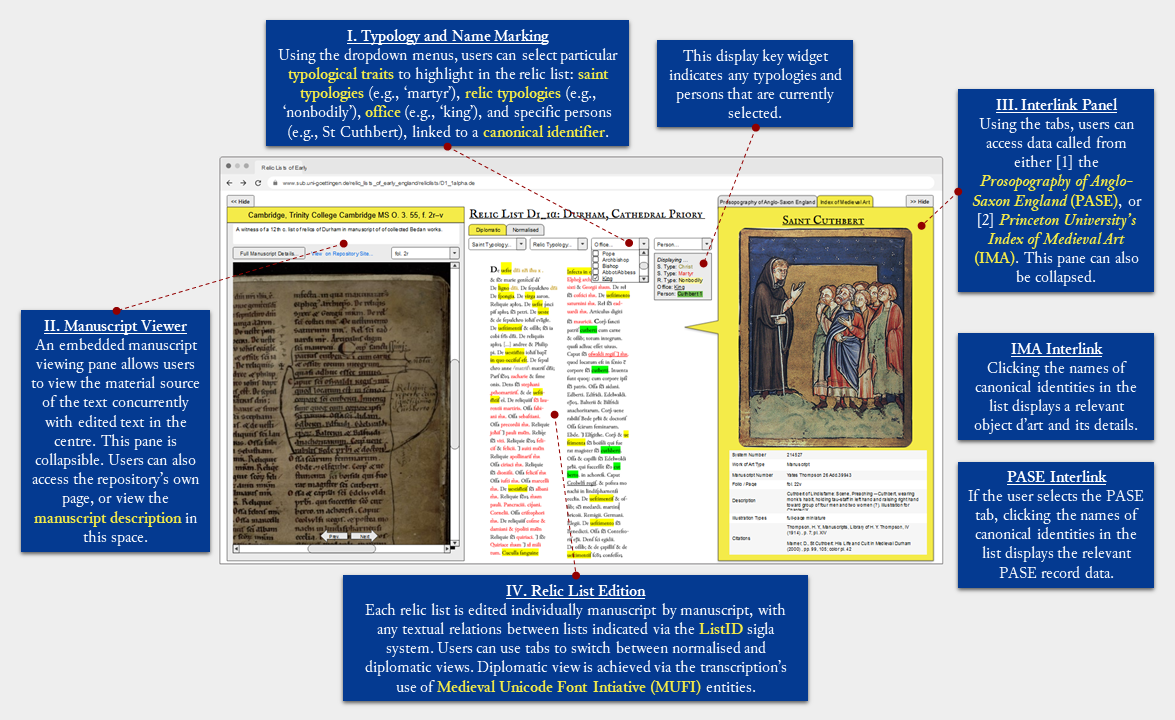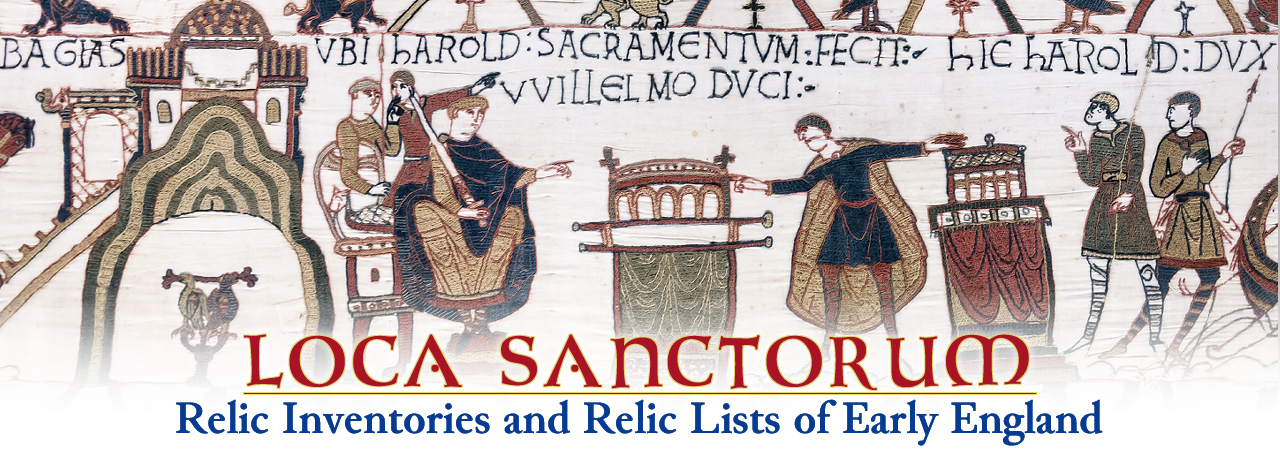
 Return to Index
Return to Index
Loca Sanctorum is only a beta website for the final end product: a digital text-object-manuscript edition of the corpus of the relic lists localisable to England dating to between ca. 1075 and 1286. This edition seeks to begin answering to an expressed desideratum for an edited collection of all the medieval English relic lists and related texts.

The edition will be transcribed using Extensible Markup Language (XML), following the TEI Consortium guidelines for digital XML editing. See below for a detailed breakdown of this diagrammed mockup.
There are four types of data most central to reading and using relic lists:
Conveniently, TEI’s architecture provides for markup options of each of these traits using attribute classes and attributes.
The class att.naming allows for reference codes to specific entities from a controlled reference vocabulary as well as more general characteristics assigned using the @role attribute, which can even be given multiple values (read more here). This is a very flexible markup method, so defining office traits for the listed relic’s personage (e.g., confessor, king, apostle, martyr, etc.) can be marked up either with, or without, a more specific @ref attribute intended to point back to the controlled list of canonical persons. Furthermore, the @ana attribute can be applied flexibly in any element, so it can be used in combination with the ‘word’ tag, <w>, all contained by <item>, in order to mark the typology of a relic, or distinguish a specific office. An idealized, simplified scenario appears as follows:
 Manuscript [D1, fol. 2r] : ‘de uestim̄tiſ ſcī albani mr̄’
Manuscript [D1, fol. 2r] : ‘de uestim̄tiſ ſcī albani mr̄’
<TEI>
<list>
<item><w>de</w> <w ana="non_body">ueſtim̄tiſ</w>
<name role="martyr" ref="#Alban01">
<w>ſcī</w> <w>albani</w> <w>mr̄</w>
</name>
</item>
</list>
</TEI>It would not be reasonable to mark up every single list item to this extent, as this would require adherence to a vast controlled vocabulary and constant reference to the bevy of indices of saints (indeed, the lists’ saints have still not been completely indexed). Thus, the entities to be marked up have been limited to a specific pool. Entities that have been selected for typology markup are shown below.
| Saint Typology Attributes | Saint Office Attributes | Relic Typology Attributes |
|---|---|---|
| Christ | Archbishop/Pope | Whole Body |
| Mother Mary | Bishop | Greater Body (e.g., arm) |
| Apostle | Abbot/Abbess | Lesser Body (e.g., tooth) |
| Old Testament Other | Other Eccelsiastic | Bodily Fluid (e.g., tears) |
| New Testament Other | Uncertain Eccelsiastic | Oil |
| Martyr | King/Queen | Ash |
| Confessor | Noble | Nonbodily (e.g., clothing) |
| Virgin | Other Secular | Uncertain |
| Uncertain | Uncertain Secular | Unstated |
| Unstated | Unstated |
Using @ref, a subset of figures appearing in the relic lists will also be marked up with a unique identifier for canonical identities. The controlled vocabulary pool for these identities consists of 212 identifiers for both local Insular saints and more broadly venerated figures based on sources demonstrating the most important saints in the Early English Church: the reconstructed Ælfrician Sanctorale, the Secgan be, an Old English resting-place list of the bodies of local saints, and the Old English Martyrology. This additional markup, when expanded with URLs added via @corresp, will enable direct interlinking between the edition’s text, the Index of Medieval Art, and the entries on the Prosopography of Anglo-Saxon England database. The provisional list of @ref tags is available here. Assignment of @ref values and other markup will refer to prior indexing when available, or else default to the text itself. For example, all list items placed under the heading ‘Martyrs’ will be tagged <role="martyr">, even if the saint cannot be readily identified as a martyr.
The manuscript viewer will include core functionalities such as zoom, pan, and book and single-leaf views. The viewer will default to displaying the incipit of the relic list but allow viewing of the full manuscript when possible. Links to manuscript context files with further editorial details of each relic list will appear above the manuscript viewport itself. Key manuscript metadata (repository, shelfmark, brief description, dating) will also appear in this space for convenient user reference
Using the encoded @ref tags that correspond to specific canonical identities in the lists, the interlink panel will allow users to instantly view relevant information about that canonical identity. When the user chooses to interlink with the Prosopography of Anglo-Saxon England and clicks a highlighted person’s name, the person’s ‘Factoid List’ will display. When the user activates interlinking with the Index of Medieval Art, an associated object d’art and its information card will display on click (e.g., Work of Art: System Number 103931). Users will then be able to view further artwork at random for that person directly in the interlink panel.
Using characters developed by MUFI, the project aims to display both a highly diplomatic transcription, as well as normalised alternative, for each relic list. Prolegomena and other preliminaries, or other similar ‘containing texts’, will also be edited alongside the list itself when said texts are not of great length and are particularly crucial. Because of the particular philological nature of lists, each list will be transcribed in a version-by-version approach. However, the transcription will use parallel segmentation, using it rather to include input from prior editors rather than related witnesses. The philological filiation between certain lists will be indicated through the specialised listID system developed here on Loca Sanctorum.
If you're looking for information about the editor of this project, try this page.
Return to Index